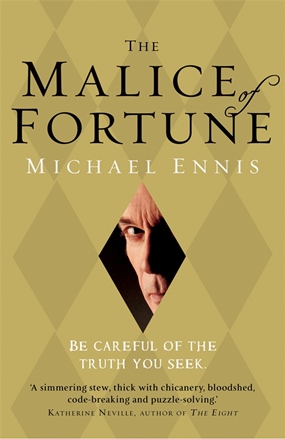Italy 1502 is the setting for this absorbing historical thriller, providing the reader an insight into the times of the Borgia family Popes. Entitled The Malice of Fortune, and written by Michael Ennis (ISBN 978-0-09-957979-3, Arrow Books, 2012) it was made available by Bookazine in The Avenue.
In his Author’s Note, Michael Ennis details the data that was left for posterity by Niccolo Machiavelli and Leonardo da Vinci. That the research was in depth goes without saying. Eight volumes and 52 diplomatic dispatches from Machiavelli, whilst da Vinci’s works were less organized but included thousands of notebook pages.

Duke Valentino, the eldest son of the Pope, is shown through Machiavelli’s writings as a most strange individual. A brilliant strategist in war, and a totally profligate person in peace. “His conscience-free, lethal expedience providing a remarkably effective and enduring template for sociopaths seeking power in any time, place, or organization; the same amoral realpolitik that has guided mass-murdering dictators is now studied by corporate CEOs and marketed as career advice for middle-management schemers.” And that leaves you in no doubt as to what is thought of Valentino!
As well as describing life in 1502, the book also details items such as the clothing worn by the women in those days. Not the simple garb of today, but outer garments fashioned with color and bead decoration. The food consumed by the upper classes in 1502 was like that eaten today in five star restaurants, with desserts made of sugar crystals in the shape of unicorns.
It is a medieval thriller, narrated principally by Damiata the Roman courtesan, in which Machiavelli and da Vinci are exhuming a body which had been cut into four quarters, and then beheaded. A body that could show the guilty parties in the assassination of Juan, Valentino’s younger brother.
In the meantime, Damiata continues to try and find Juan’s killers, because the Pope holds her son as hostage. All very convoluted! Add to that the warring mercenaries, under dukes not paying any allegiance to the Pope at that time.
The chapters are short to keep the interest of the reader, and the ‘chase’ scenes take the reader through all sorts of interesting places, including the rough brothels of the day.
After growing a little lost initially, I warmed to this book, and you will too!
B. 385 for a fairly weighty tome of the same number of pages. This book requires the reader to have at least a cursory interest in history, and specifically that of the Borgias at the beginning of the 1500’s. Combined with the search for the killers, this results in a historic who-dunnit of riveting attention.
Whilst reading the book, I was reminded of Dan Brown’s The daVinci Code, but it is not a book attempting to piggyback on Brown’s very successful novels. In many ways, Ennis has been more faithful to the realities of those days, though the plot is similarly a contorted one. Perhaps the more telling factor is that Brown sets his ‘historical’ novels in the present day, whilst Ennis sets his in the period, in this case 1502.




